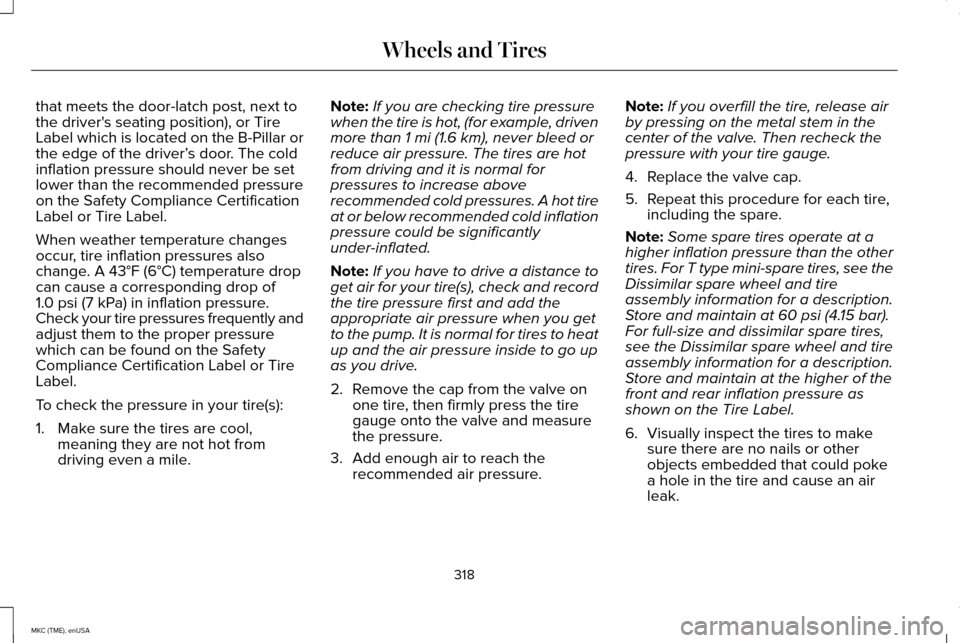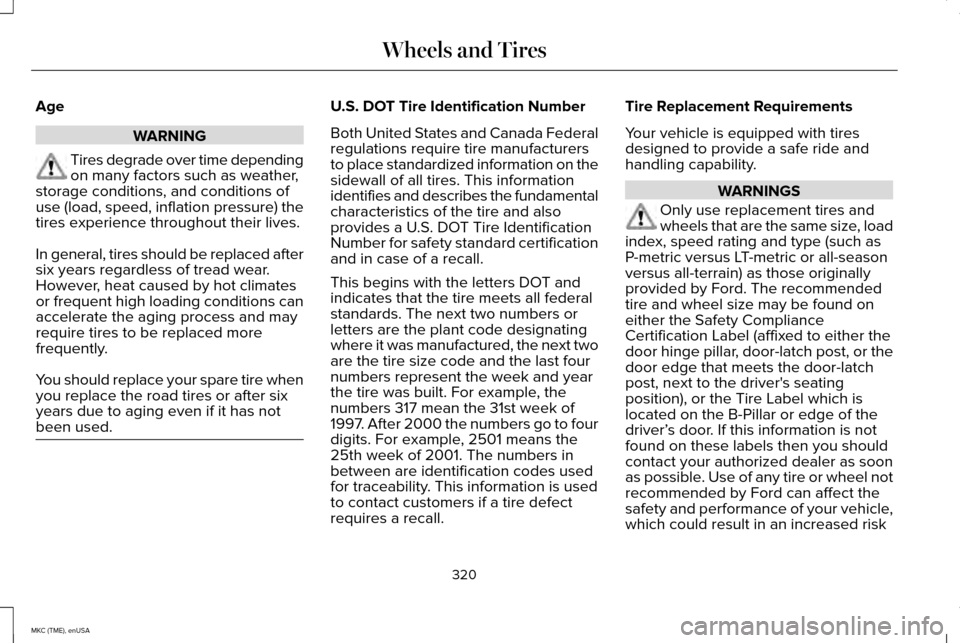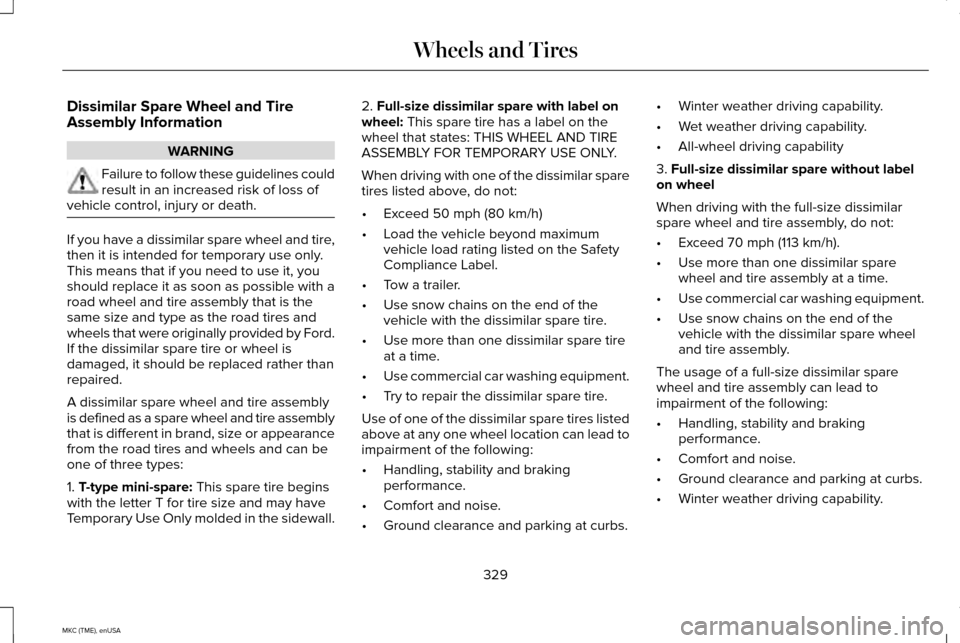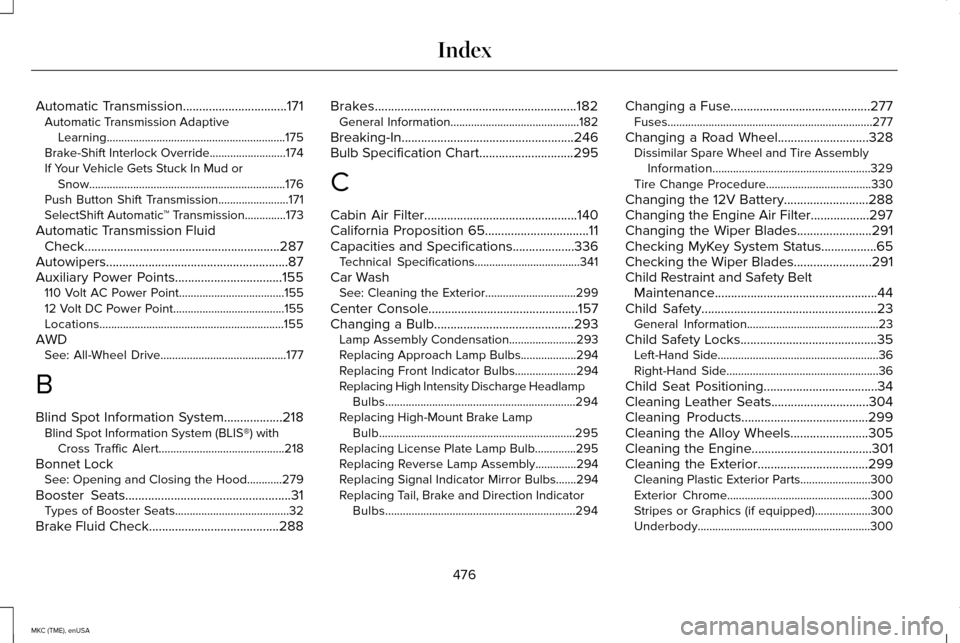tire type LINCOLN MKC 2015 User Guide
[x] Cancel search | Manufacturer: LINCOLN, Model Year: 2015, Model line: MKC, Model: LINCOLN MKC 2015Pages: 490, PDF Size: 4.74 MB
Page 321 of 490

that meets the door-latch post, next to
the driver's seating position), or Tire
Label which is located on the B-Pillar or
the edge of the driver’
s door. The cold
inflation pressure should never be set
lower than the recommended pressure
on the Safety Compliance Certification
Label or Tire Label.
When weather temperature changes
occur, tire inflation pressures also
change. A 43°F (6°C) temperature drop
can cause a corresponding drop of
1.0 psi (7 kPa)
in inflation pressure.
Check your tire pressures frequently and
adjust them to the proper pressure
which can be found on the Safety
Compliance Certification Label or Tire
Label.
To check the pressure in your tire(s):
1. Make sure the tires are cool, meaning they are not hot from
driving even a mile. Note:
If you are checking tire pressure
when the tire is hot, (for example, driven
more than
1 mi (1.6 km), never bleed or
reduce air pressure. The tires are hot
from driving and it is normal for
pressures to increase above
recommended cold pressures. A hot tire
at or below recommended cold inflation
pressure could be significantly
under-inflated.
Note: If you have to drive a distance to
get air for your tire(s), check and record
the tire pressure first and add the
appropriate air pressure when you get
to the pump. It is normal for tires to heat
up and the air pressure inside to go up
as you drive.
2. Remove the cap from the valve on
one tire, then firmly press the tire
gauge onto the valve and measure
the pressure.
3. Add enough air to reach the recommended air pressure. Note:
If you overfill the tire, release air
by pressing on the metal stem in the
center of the valve. Then recheck the
pressure with your tire gauge.
4. Replace the valve cap.
5. Repeat this procedure for each tire,
including the spare.
Note: Some spare tires operate at a
higher inflation pressure than the other
tires. For T type mini-spare tires, see the
Dissimilar spare wheel and tire
assembly information for a description.
Store and maintain at
60 psi (4.15 bar).
For full-size and dissimilar spare tires,
see the Dissimilar spare wheel and tire
assembly information for a description.
Store and maintain at the higher of the
front and rear inflation pressure as
shown on the Tire Label.
6. Visually inspect the tires to make
sure there are no nails or other
objects embedded that could poke
a hole in the tire and cause an air
leak.
318
MKC (TME), enUSA Wheels and Tires
Page 323 of 490

Age
WARNING
Tires degrade over time depending
on many factors such as weather,
storage conditions, and conditions of
use (load, speed, inflation pressure) the
tires experience throughout their lives.
In general, tires should be replaced after
six years regardless of tread wear.
However, heat caused by hot climates
or frequent high loading conditions can
accelerate the aging process and may
require tires to be replaced more
frequently.
You should replace your spare tire when
you replace the road tires or after six
years due to aging even if it has not
been used. U.S. DOT Tire Identification Number
Both United States and Canada Federal
regulations require tire manufacturers
to place standardized information on the
sidewall of all tires. This information
identifies and describes the fundamental
characteristics of the tire and also
provides a U.S. DOT Tire Identification
Number for safety standard certification
and in case of a recall.
This begins with the letters DOT and
indicates that the tire meets all federal
standards. The next two numbers or
letters are the plant code designating
where it was manufactured, the next two
are the tire size code and the last four
numbers represent the week and year
the tire was built. For example, the
numbers 317 mean the 31st week of
1997. After 2000 the numbers go to four
digits. For example, 2501 means the
25th week of 2001. The numbers in
between are identification codes used
for traceability. This information is used
to contact customers if a tire defect
requires a recall.
Tire Replacement Requirements
Your vehicle is equipped with tires
designed to provide a safe ride and
handling capability.
WARNINGS
Only use replacement tires and
wheels that are the same size, load
index, speed rating and type (such as
P-metric versus LT-metric or all-season
versus all-terrain) as those originally
provided by Ford. The recommended
tire and wheel size may be found on
either the Safety Compliance
Certification Label (affixed to either the
door hinge pillar, door-latch post, or the
door edge that meets the door-latch
post, next to the driver's seating
position), or the Tire Label which is
located on the B-Pillar or edge of the
driver’ s door. If this information is not
found on these labels then you should
contact your authorized dealer as soon
as possible. Use of any tire or wheel not
recommended by Ford can affect the
safety and performance of your vehicle,
which could result in an increased risk
320
MKC (TME), enUSA Wheels and Tires
Page 332 of 490

Dissimilar Spare Wheel and Tire
Assembly Information
WARNING
Failure to follow these guidelines could
result in an increased risk of loss of
vehicle control, injury or death. If you have a dissimilar spare wheel and tire,
then it is intended for temporary use only.
This means that if you need to use it, you
should replace it as soon as possible with a
road wheel and tire assembly that is the
same size and type as the road tires and
wheels that were originally provided by Ford.
If the dissimilar spare tire or wheel is
damaged, it should be replaced rather than
repaired.
A dissimilar spare wheel and tire assembly
is defined as a spare wheel and tire assembly
that is different in brand, size or appearance
from the road tires and wheels and can be
one of three types:
1. T-type mini-spare: This spare tire begins
with the letter T for tire size and may have
Temporary Use Only molded in the sidewall. 2.
Full-size dissimilar spare with label on
wheel: This spare tire has a label on the
wheel that states: THIS WHEEL AND TIRE
ASSEMBLY FOR TEMPORARY USE ONLY.
When driving with one of the dissimilar spare
tires listed above, do not:
• Exceed 50 mph (80 km/h)
• Load the vehicle beyond maximum
vehicle load rating listed on the Safety
Compliance Label.
• Tow a trailer.
• Use snow chains on the end of the
vehicle with the dissimilar spare tire.
• Use more than one dissimilar spare tire
at a time.
• Use commercial car washing equipment.
• Try to repair the dissimilar spare tire.
Use of one of the dissimilar spare tires listed
above at any one wheel location can lead to
impairment of the following:
• Handling, stability and braking
performance.
• Comfort and noise.
• Ground clearance and parking at curbs. •
Winter weather driving capability.
• Wet weather driving capability.
• All-wheel driving capability
3.
Full-size dissimilar spare without label
on wheel
When driving with the full-size dissimilar
spare wheel and tire assembly, do not:
• Exceed 70 mph (113 km/h).
• Use more than one dissimilar spare
wheel and tire assembly at a time.
• Use commercial car washing equipment.
• Use snow chains on the end of the
vehicle with the dissimilar spare wheel
and tire assembly.
The usage of a full-size dissimilar spare
wheel and tire assembly can lead to
impairment of the following:
• Handling, stability and braking
performance.
• Comfort and noise.
• Ground clearance and parking at curbs.
• Winter weather driving capability.
329
MKC (TME), enUSA Wheels and Tires
Page 479 of 490

Automatic Transmission................................171
Automatic Transmission Adaptive
Learning.............................................................175
Brake-Shift Interlock Override..........................174
If Your Vehicle Gets Stuck In Mud or Snow...................................................................176
Push Button Shift Transmission........................171
SelectShift Automatic ™ Transmission..............173
Automatic Transmission Fluid Check............................................................287
Autowipers........................................................87
Auxiliary Power Points.................................155 110 Volt AC Power Point....................................155
12 Volt DC Power Point......................................155
Locations...............................................................155
AWD See: All-Wheel Drive...........................................177
B
Blind Spot Information System
..................218
Blind Spot Information System (BLIS®) with
Cross Traffic Alert...........................................218
Bonnet Lock See: Opening and Closing the Hood............279
Booster Seats...................................................31 Types of Booster Seats.......................................32
Brake Fluid Check
........................................288 Brakes..............................................................182
General Information............................................182
Breaking-In.....................................................246
Bulb Specification Chart
.............................295
C
Cabin Air Filter
...............................................140
California Proposition 65................................11
Capacities and Specifications
...................336
Technical Specifications....................................341
Car Wash See: Cleaning the Exterior...............................
299
Center Console
..............................................157
Changing a Bulb...........................................293
Lamp Assembly Condensation.......................293
Replacing Approach Lamp Bulbs...................294
Replacing Front Indicator Bulbs.....................294
Replacing High Intensity Discharge Headlamp
Bulbs.................................................................294
Replacing High-Mount Brake Lamp Bulb...................................................................295
Replacing License Plate Lamp Bulb..............295
Replacing Reverse Lamp Assembly..............
294
Replacing Signal Indicator Mirror Bulbs.......294
Replacing Tail, Brake and Direction Indicator Bulbs.................................................................294 Changing a Fuse...........................................277
Fuses......................................................................277
Changing a Road Wheel............................328 Dissimilar Spare Wheel and Tire Assembly
Information......................................................329
Tire Change Procedure....................................
330
Changing the 12V Battery..........................288
Changing the Engine Air Filter..................297
Changing the Wiper Blades.......................291
Checking MyKey System Status
.................65
Checking the Wiper Blades........................291
Child Restraint and Safety Belt Maintenance..................................................44
Child Safety......................................................23 General Information.............................................23
Child Safety Locks..........................................35 Left-Hand Side.......................................................36
Right-Hand Side....................................................36
Child Seat Positioning...................................34
Cleaning Leather Seats..............................304
Cleaning Products
.......................................299
Cleaning the Alloy Wheels........................305
Cleaning the Engine.....................................301
Cleaning the Exterior..................................299 Cleaning Plastic Exterior Parts........................
300
Exterior Chrome.................................................300
Stripes or Graphics (if equipped)...................300
Underbody...........................................................300
476
MKC (TME), enUSA Index